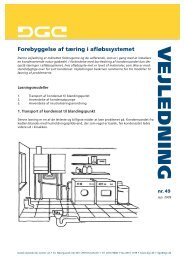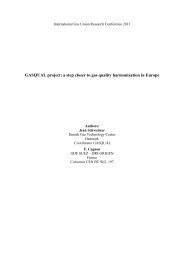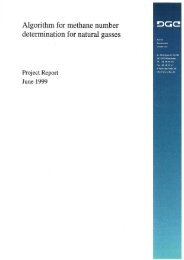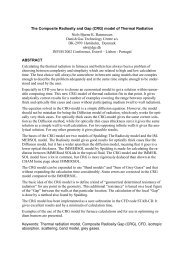- Page 1 and 2: Establishment of a biogas grid andi
- Page 3 and 4: Title : Establishment of a biogas g
- Page 5 and 6: DGC-report 2AppendicesAppendix 1: O
- Page 7 and 8: DGC-report 42 Background2.1 A bioga
- Page 9 and 10: DGC-report 62.2 Examined subjectsTh
- Page 11 and 12: DGC-report 8DKK per year or 0,19 DK
- Page 13 and 14: DGC-report 10Table 2Average market
- Page 15 and 16: DGC-report 125 Gas quality and meas
- Page 17 and 18: DGC-report 14crease in maintenance
- Page 19: DGC-report 16Furthermore, the analy
- Page 23 and 24: DGC-report 208 Design of the biogas
- Page 25 and 26: DGC-report 228.1.1 Alternative appl
- Page 27 and 28: DGC-report 24to own and operate bio
- Page 29 and 30: DGC-report 26The minimum gas requir
- Page 31: Appendix 1Produktion og afsætningW
- Page 34 and 35: 2IndholdsfortegnelseSide1 Indlednin
- Page 36 and 37: 42 ProduktionspotentialeRinkøbing
- Page 38 and 39: 6400.000350.000Naturgasforbrug / m
- Page 40 and 41: 8Månedsforbrug i NG-ækvi. m 37.00
- Page 42 and 43: 10pr. kWh opgraderet gas) med stige
- Page 44 and 45: opgraderingen. Det skyldes at til m
- Page 46 and 47: 14I stedet for at opgradere hele de
- Page 48 and 49: Tabel 5. Effekt af sæsonvarieret b
- Page 50 and 51: 18me på kraftvarmeværker i Danmar
- Page 52 and 53: 20Figur 11. Princippet i geotermisk
- Page 54 and 55: 22Figur 13, Driftsfilosofi for det
- Page 56 and 57: 247 Referencer[1] Nedgradering af g
- Page 59 and 60: DGC-notat 1/19Forøget biogasandel
- Page 61 and 62: DGC-notat 3/19IndledningI Danmark a
- Page 63 and 64: DGC-notat 5/19Figur 1. Energistyrel
- Page 65 and 66: DGC-notat 7/19øgede samproduktion
- Page 67 and 68: DGC-notat 9/19Figur 3. Varighedskur
- Page 69 and 70: DGC-notat 11/19anvende gaslagre, en
- Page 71 and 72:
DGC-notat 13/19Biogas og elprodukti
- Page 73 and 74:
DGC-notat 15/19produktionen når el
- Page 75 and 76:
DGC-notat 17/19Figur 12. Bergnet me
- Page 77 and 78:
DGC-notat 19/19Referencer[1] Lokal
- Page 80 and 81:
DGC-notat 1/28Biogasnettet i Ringk
- Page 82 and 83:
DGC-notat 3/28IndledningNærværend
- Page 84 and 85:
DGC-notat 5/28komme korrosionsskade
- Page 86 and 87:
DGC-notat 7/28Note 1:Det svenske re
- Page 88 and 89:
DGC-notat 9/28nettet, blev testet h
- Page 90 and 91:
DGC-notat 11/28Siemens er blevet ko
- Page 92 and 93:
DGC-notat 13/28Tabel 1. Omkostninge
- Page 94 and 95:
DGC-notat 15/28Figur 2 GTP-filter f
- Page 96 and 97:
DGC-notat 17/28Sulfurex®fuldlast[8
- Page 98 and 99:
DGC-notat 19/28- Ultralydsmålere-
- Page 100 and 101:
DGC-notat 21/28Tabel 6. Forskellige
- Page 102 and 103:
DGC-notat 23/28Figur af flere typer
- Page 104 and 105:
DGC-notat 25/28Et emne, der har væ
- Page 106 and 107:
DGC-notat 27/28KontrolsystemFor at
- Page 108:
Appendix 4Økonomiske overvejelser
- Page 111 and 112:
SammenfatningI denne arbejdspakke e
- Page 113 and 114:
at etablere et antal biogasanlæg o
- Page 115 and 116:
højeste og mest stabile biogasafre
- Page 117 and 118:
værkets varmebehov og lagerkapacit
- Page 119 and 120:
Gaskøb: Gaspris består normalt af
- Page 121 and 122:
Reglerne i varmeforsyningsloven bet
- Page 123 and 124:
De er dermed forpligtede til at lev
- Page 125 and 126:
formidler kraftvarmeværkets bud ti
- Page 127 and 128:
efter en gaspris relateret til en o
- Page 129 and 130:
Biogas som brændsel er ikke identi
- Page 131 and 132:
incitament til biogasMuligheder Bes
- Page 133 and 134:
Figur 6: Fordelingskurve på døgnb
- Page 135 and 136:
3. Biogas som grundlast i det frie
- Page 137 and 138:
Gas- og elpris 2008-200970060050040
- Page 139 and 140:
Varmepris Biogaspris BiogasprisInve
- Page 141 and 142:
motor og turbineanlæg. Derudover f
- Page 143 and 144:
udgøre mellem ca. 355 og 410 kr/MW
- Page 145 and 146:
Bilag 1Værknavn Spjald 2009Årspro
- Page 147 and 148:
Bilag 3 - Driftsøkonomiske beregni
- Page 149 and 150:
Spjald 2008Biogas som grundlast mar
- Page 151 and 152:
Spjald 2008Biogas marked 150 % jan
- Page 153 and 154:
Spjald 2009Biogas som grundlast jan
- Page 155 and 156:
Spjald 2009Biogas grundlast 150 % j
- Page 157 and 158:
Bilag 4 - Driftsøkonomiske beregni
- Page 159 and 160:
Ringkøbing 2008Biogas som grundlas
- Page 161 and 162:
Ringkøbing 2008Biogas marked 150 %
- Page 163 and 164:
Ringkøbing 2009Biogas som grundlas
- Page 165 and 166:
Ringkøbing 2009Biogas grundlast 15
- Page 167:
Appendix 5Ombygning af naturgasmoto
- Page 170 and 171:
DGC-notat 2/18IndholdfortegnelseIND
- Page 172 and 173:
DGC-notat 4/18IntroduktionFælles f
- Page 174 and 175:
DGC-notat 6/18Samspil mellem biogas
- Page 176 and 177:
DGC-notat 8/18ReceiverMotorLuftBræ
- Page 178 and 179:
DGC-notat 10/18Wärtsilä har ingen
- Page 180 and 181:
DGC-notat 12/18hvis andelen af natu
- Page 182 and 183:
DGC-notat 14/18Hvis det antages, at
- Page 184 and 185:
DGC-notat 16/18gældende for naturg
- Page 186 and 187:
DGC-notat 18/18Referencer[ 1]http:/
- Page 190:
Bilag 2.Jenbacher - Brændstofspeci
- Page 204 and 205:
Motoren i Ådum.Budget - Ombygning
- Page 206 and 207:
Motorene i Kloster.Budget - Ombygni
- Page 208 and 209:
Motoren i Videbæk.Budget - Ombygni
- Page 210:
Appendix 6Design af biogasnetWritte
- Page 213 and 214:
Figur 1. Biogaspotentiale samt forv
- Page 215 and 216:
Det er forudsat, at biogassen ikke
- Page 217 and 218:
Omkostningerne til konvertering af
- Page 219 and 220:
iogasproduktionen fra Ringkøbing-S
- Page 221 and 222:
Opgraderingsprojektet er således c
- Page 224 and 225:
1. december , 2010Lars BaadstorpLar
- Page 226 and 227:
isiko og omkostning (og værditilv
- Page 228 and 229:
3.2.2 BeV leasingBeV leasing ejer o
- Page 230 and 231:
Ejet af BeV leasingI forhold til Be
- Page 232 and 233:
kan sidestilles med de vedtægter o
- Page 234 and 235:
Ejerkredsen er i opstartsfasen lukk
- Page 236 and 237:
BeV handel kan overvåge produktion
- Page 238 and 239:
Aftalerne mellem parterneI aftalern
- Page 240 and 241:
I projektets første fase vil inves
- Page 242 and 243:
Der kan være behov for at begræns
- Page 244 and 245:
mest fordelagtige tilbud. De nærme
- Page 246 and 247:
Klor (Cl):NH 3Halgoen:Maksimalt 50
- Page 248 and 249:
døgnlagrene. Dette vil dermed ikke
- Page 250 and 251:
10t gas fylder ca. 8.475 m 3 med et
- Page 253 and 254:
IndholdsfortegnelseSammendrag .....
- Page 255 and 256:
de biogas afsættes til procesindus
- Page 257 and 258:
ForudsætningerGaspotentialeEtape 1
- Page 259 and 260:
Yderligere skal der foretages læka
- Page 261 and 262:
Tabel 4: LeasingydelserEtape 1Etape
- Page 263 and 264:
neste eller opnå break-evenafhæng
- Page 265 and 266:
Investering vedr. etape 2Transmissi
- Page 267 and 268:
NøgletalLandmændenes indtjeningSi
- Page 269 and 270:
den af gas til fjernvarmeværkerne
- Page 271 and 272:
Simpel tilbagebetalingstidÅrligt c
- Page 273 and 274:
negativindflydelsee på Bioenergi V



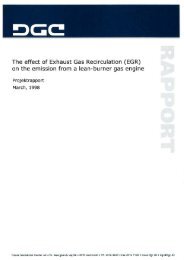

![Hybrid heating systems and smart grid [PDF] - Danish Gas ...](https://img.yumpu.com/46620218/1/184x260/hybrid-heating-systems-and-smart-grid-pdf-danish-gas-.jpg?quality=85)
